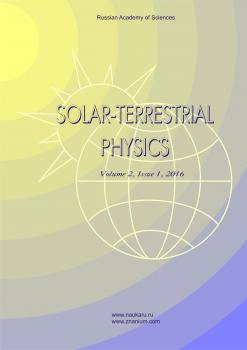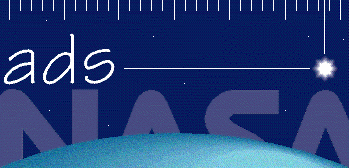с 01.01.2009 по настоящее время
Санкт-Петербург, г. Санкт-Петербург и Ленинградская область, Россия
Numerical simulation has been used to examine the effect of changes in solar activity (SA) in the thermosphere on amplitudes of long-period planetary waves (PW) for the winter period in the Northern Hemisphere. The model of the middle and upper atmosphere (MUAM) is used. It allows simulations of general atmospheric circulation at altitudes 0–300 km. In order to reproduce SA changes, different values of the solar radio flux at a wavelength of 10.7 cm at an altitude of more than 100 km are set in the MUAM radiation block. To take into account the effect of charged particles in the ionosphere on the neutral gas dynamics, ionospheric conductivities for different SA levels are included in MUAM. To improve the statistical reliability of the results, two ensembles of model simulations consisting of 16 runs corresponding to the minimum and maximum SA have been obtained. The statistical confidence of average differences in PW amplitudes between high and low SA has been calculated. The results are shown to be reliable in almost the entire altitude range 0–300 km. Results of the simulations have shown for the first time that statistically significant differences in amplitudes of long-period PWs can reach 10–15 % in the middle atmosphere of the Northern Hemisphere, depending on the zonal wave number. At the same time, reflection of PWs at altitudes of lower thermosphere has a significant effect on the PW structure in the middle atmosphere.
general circulation, planetary waves, numerical simulation, solar activity
1. Andrews D.G., Holton J.R., Leovy C.B. Middle Atmosphere Dynamics. New York, Acad. Press, 1987. 489 p.
2. Arnold N.F., Robinson T.R. Solar cycle changes to planetary wave propagation and their influence on the middle atmosphere circulation. Ann. Geophys. 1998, vol. 16, iss. 1, pp. 69−76. DOI:https://doi.org/10.1007/s00585-997-0069-3.
3. Bruevich E.A., Yakunina G.V. The cyclic activity of the sun from observations of the activity indices at different time scales. Moscow University Physics Bulletin. 2015, vol. 70, iss. 4, pp. 282-290.
4. Chang L.C., Yue L., Wang W., Wu Q., Meier R.R. Quasi two day wave-related variability in the background dynamics and composition of the mesosphere/thermosphere and the ionosphere. J. Geophys. Res.: Space Phys. 2014, vol. 119, iss. 6, pp. 4786-4804. DOI:https://doi.org/10.1002/2014JA019936.
5. Charney J.G., Drazin P.G. Propagation of planetary-scale disturbances from the lower into the upper atmosphere. J. Geophys. Res. 1961, vol. 66, no. 1, pp. 83-109.
6. Dahiya R.C., Gurland J. How many classes in the Pearson Chi-square test? Journal of the American Statistical Association. 1973, vol. 68, no. 343, pp. 707-712. DOI:https://doi.org/10.2307/2284803.
7. Doerffel K. Statistika v analiticheskoi khimii [Statistics in analytical chemistry: translation from German]. Moscow, Mir, 1994. 268 p. (in Russian). (German edition: Doerffel K. Statistik in der analytischen Chemie. Leipzig, VEB Deutscher Verlag für Grundstoffindustrie, 1982.)
8. Forbes J. M., Zhang X., Ward W., Talaat E.R. Climatological features of mesosphere and lower thermosphere stationary planetary waves within ±40 latitude. J. Geophys. Res. 2002, vol. 107, iss. D17, 4322. DOI:https://doi.org/10.1029/2001JD001232.
9. Fröhlich K., Pogoreltsev A., Jacobi Ch. Numerical simulation of tides, Rossby and Kelvin waves with the COMMA-LIM model. Adv. Space Res. 2003, vol. 32, iss. 5, pp. 863-868. DOI:https://doi.org/10.1016/S0273-1177(03)00416-2.
10. Gavrilov N.M. Parameterization of momentum and energy depositions from gravity waves generated by tropospheric hydrodynamic sources. Ann. Geophys. 1997, vol. 15, iss. 12, pp. 1570-1580. DOI:https://doi.org/10.1007/s00585-997-1570-4.
11. Gavrilov N.M., Koval A.V. Parameterization of mesoscale stationary orographic wave forcing for use in numerical models of atmospheric dynamics. Izvestiya. Atmos. Ocean. Phys. 2013, vol. 49, iss. 3, pp. 244-251. DOI:https://doi.org/10.1134/S0001433813030067.
12. Gavrilov N.M., Pogoreltsev A.I., Jacobi Ch. Numerical modeling of the effect of latitude-inhomogeneous gravity waves on the circulation of the middle atmosphere. Izvestiya. Atmos. Ocean. Phys. 2005, vol. 41, iss. 1, pp. 9-18.
13. Geller M. A., Alpert J.C. Planetary wave coupling between the troposphere and the middle atmosphere as a possible Sun-weather mechanism. J. Atmos. Sci. 1980, vol. 37, pp. 1197-1215.
14. Hathaway D.H. The Solar Cycle. Living Rev. Solar Phys. 2010, vol. 12, 4. DOI:https://doi.org/10.1007/lrsp-2015-4.
15. Holton J.R. The Dynamic Meteorology of the Stratosphere and Mesosphere. 1975, 218 p. (Meteorol. Monographs, vol. 15, no. 37).
16. Jacobi Ch., Hoffmann P., Kurschner D. Trends in MLT region winds and planetary waves, Collm (52° N, 15° E). Ann. Geophys. 2008, vol. 26, iss. 5, pp. 1221-1232. DOI:https://doi.org/10.5194/angeo-26-1221-2008.
17. Kobayashi S., Ota Y., Harada H., Ebita A., Moriya M., Onoda H., Onogi K., et al. The JRA-55 Reanalysis: general specifications and basic characteristics. J. Meteorol. Soc. Japan. 2015, vol. 93, iss. 1, pp. 5−48. DOI:https://doi.org/10.2151/jmsj.2015-001.
18. Kobzar A.I. Prikladnaya matematicheskaya statistika [Applied mathematical statistics]. Moscow, Fizmatlit Publ., 2006, 816 p. (In Russian).
19. Koval A.V., Gavrilov N.M, Pogoreltsev A.I., Shevchuk N.O. Influence of solar activity on penetration of traveling planetary-scale waves from the troposphere into the thermosphere. J. Geophys. Res.: Space Phys. 2018a, vol. 123, iss. 8, pp. 6888-6903. DOI:https://doi.org/10.1029/2018JA025680.
20. Koval A.V., Gavrilov N.M., Pogoreltsev A.I., Shevchuk N.O. Propagation of stationary planetary waves to the thermosphere at different levels of solar activity. J. Atmos. Solar-Terr. Phys. 2018b, vol. 173, pp. 140-149. DOI:https://doi.org/10.1016/j.jastp.2018.03.012.
21. Krivolutsky A.A., Cherepanova L.A., Dement’eva A.V., Repnev A.I., Klyuchnikova A.V. Global circulation of the Earth’s atmosphere at altitudes from 0 to 135 km simulated with the ARM model. Consideration of the solar activity contribution. Geomagnetism and Aeronomy. 2015, vol. 55, iss. 6, pp. 780-800. DOI:https://doi.org/10.1134/S0016793215060067.
22. Laštovicka J. Forcing of the ionosphere by waves from below. J. Atmos. Solar-Terr. Phys. 2006. V. 68, iss. 3. P. 479-497.
23. Liu H.L., Talaat E.R., Roble R.G., Lieberman R.S., Riggin D.M., Yee J.H. The 6.5-day wave and its seasonal variability in the middle and upper atmosphere. J. Geophys. Res.: Atmos. 2004, vol. 109, iss. D21, D21112. DOI: 10.1029/ 2004jd004795.
24. Lu H., Scaife A.A., Marshall G.J., Turner J., Gray L.J. Downward wave reflection as a mechanism for the stratosphere-troposphere response to the 11-year solar cycle. J. Clim. 2017, vol. 30, no. 7, pp. 2395−2414. DOI:https://doi.org/10.1175/JCLI-D-16-0400.1.
25. Mukhtarov P., Pancheva D., Andonov B. Climatology of the stationary planetary waves seen in the SABER/TIMED temperatures (2002-2007). J. Geophys. Res. 2010, vol. 115, A06315. DOI:https://doi.org/10.1029/2009JA015156.
26. Pancheva D., Lysenko I. Quasi-two-day fluctuations ob-served in the summer F region electron maximum. Bulg. Geophys. J. 1988, vol. 14, no. 2, pp. 41-51.
27. Pogorel’tsev A.I. Generation of normal atmospheric modes by stratospheric vacillations. Izvestiya. Atmos. Ocean. Phys. 2007, vol. 43, no. 4, pp. 423-435. DOI:https://doi.org/10.1134/S0001433807040044.
28. Pogoreltsev A.I., Vlasov A.A., Fröhlich K., Jacobi Ch. Planetary waves in coupling the lower and upper atmosphere. J. Atmos. Solar-Terr. Phys. 2007, vol. 69, iss. 17-18, pp. 2083-2101. DOI:https://doi.org/10.1016/j.jastp.2007.05.014.
29. Rice J.A. Mathematical Statistics and Data Analysis. 3rd edition. Pacific Grove. Duxbury Press, 2006, 603 p.
30. Richards P.G., Fennelly J.A., Torr D.G. EUVAC: a solar EUV flux model for aeronomic calculations. J. Geophys. Res. 1994, vol. 99, iss. A5, pp. 8981-8992. DOI:https://doi.org/10.1029/94JA00518.
31. Shevchuk N.O., Ortikov M.Yu., Pogoreltsev A.I. Modeling of atmospheric tides with account of diurnal variations of ionospheric conductivity. Russian Journal of Physical Chemistry B. 2018, vol. 12, no. 3, pp. 576-589. DOI: 10.1134/ S199079311803017X.
32. Tapping K.F. Recent solar radio astronomy at centimeter wavelength: The temporal variability of the 10.7-cm flux. J. Geophys. Res.: Atmos. 1987, vol. 92, iss. D1, pp. 829-838. DOI:https://doi.org/10.1029/JD092iD01p00829.
33. Vitinsky Yu.I., Kopetsky M., Kuklin G.V. Statistika pyatnoobrazovatel’noi deyatel’nosti Solntsa [Statistics of sunspot-forming activity of the Sun]. Moscow, Nauka Publ., 1986, 296 p. (In Russian).
34. Wang J.C., Chang L.C., Yue J., Wang W., Siskind D.E. The quasi 2 day wave response in TIME-GCM nudged with NOGAPS-ALPHA. J. Geophys. Res.: Space Phys. 2017, vol. 122, iss. 5, pp. 5709-5732. DOI:https://doi.org/10.1002/2016JA023745.
35. URL: http://sidc.be/silso/datafiles (accessed November 18, 2017).

















